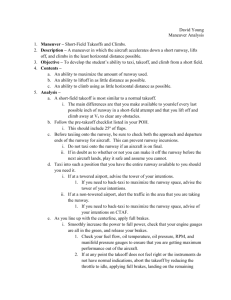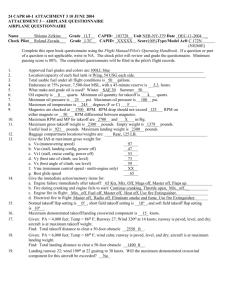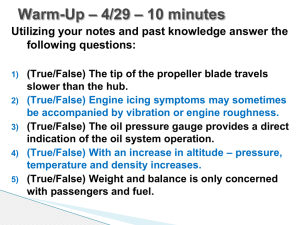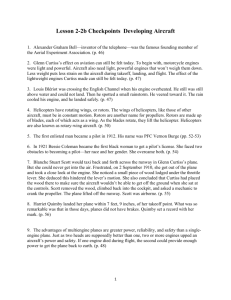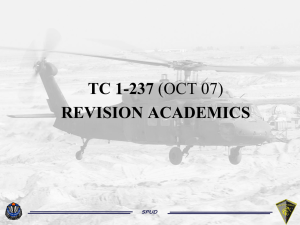VII-C-Soft-Field-Takeoff-and-Climb
advertisement
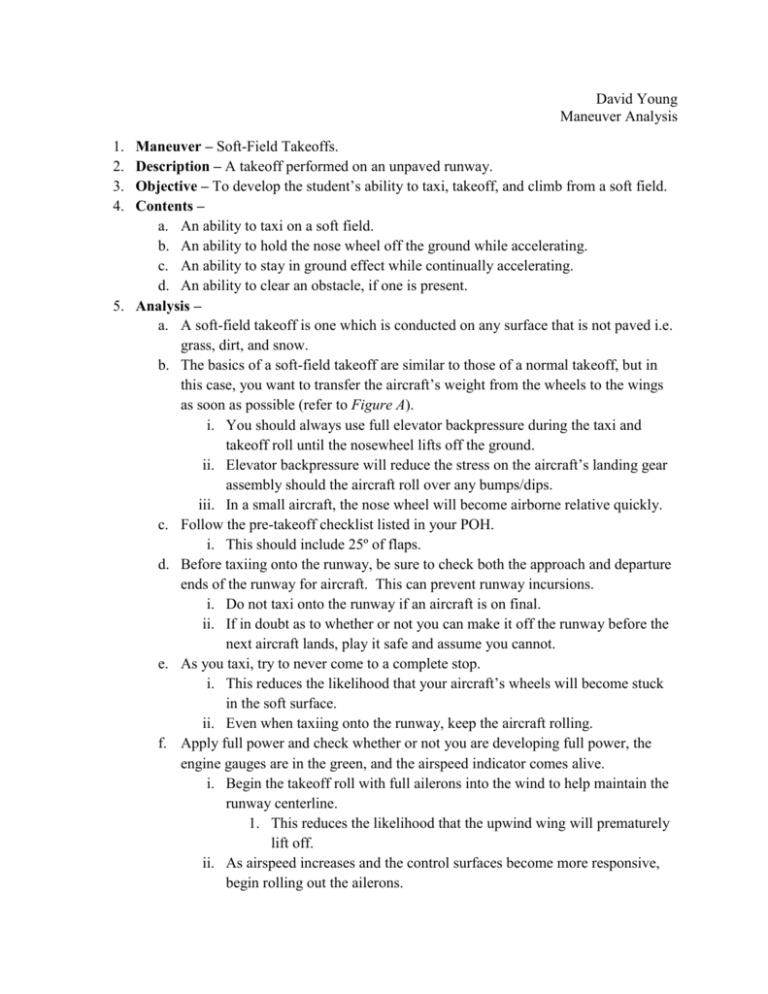
David Young Maneuver Analysis Maneuver – Soft-Field Takeoffs. Description – A takeoff performed on an unpaved runway. Objective – To develop the student’s ability to taxi, takeoff, and climb from a soft field. Contents – a. An ability to taxi on a soft field. b. An ability to hold the nose wheel off the ground while accelerating. c. An ability to stay in ground effect while continually accelerating. d. An ability to clear an obstacle, if one is present. 5. Analysis – a. A soft-field takeoff is one which is conducted on any surface that is not paved i.e. grass, dirt, and snow. b. The basics of a soft-field takeoff are similar to those of a normal takeoff, but in this case, you want to transfer the aircraft’s weight from the wheels to the wings as soon as possible (refer to Figure A). i. You should always use full elevator backpressure during the taxi and takeoff roll until the nosewheel lifts off the ground. ii. Elevator backpressure will reduce the stress on the aircraft’s landing gear assembly should the aircraft roll over any bumps/dips. iii. In a small aircraft, the nose wheel will become airborne relative quickly. c. Follow the pre-takeoff checklist listed in your POH. i. This should include 25º of flaps. d. Before taxiing onto the runway, be sure to check both the approach and departure ends of the runway for aircraft. This can prevent runway incursions. i. Do not taxi onto the runway if an aircraft is on final. ii. If in doubt as to whether or not you can make it off the runway before the next aircraft lands, play it safe and assume you cannot. e. As you taxi, try to never come to a complete stop. i. This reduces the likelihood that your aircraft’s wheels will become stuck in the soft surface. ii. Even when taxiing onto the runway, keep the aircraft rolling. f. Apply full power and check whether or not you are developing full power, the engine gauges are in the green, and the airspeed indicator comes alive. i. Begin the takeoff roll with full ailerons into the wind to help maintain the runway centerline. 1. This reduces the likelihood that the upwind wing will prematurely lift off. ii. As airspeed increases and the control surfaces become more responsive, begin rolling out the ailerons. 1. 2. 3. 4. Young 2, VII-C 1. If at any point the takeoff does not feel right or the instruments do not have normal indications, abort the takeoff by reducing the throttle to idle, applying full brakes, landing on the remaining runway, landing straight ahead (if below 2,000 ft MSL), or coming back for a landing (2,000 ft MSL or more). g. As the nosewheel lifts off the ground, reduce elevator backpressure in order to hold a “wheelie.” i. This pitch attitude will place the cowling about 1 inch above the horizon. h. As you accelerate, the main wheels will eventually lift off. i. There is no set number that this will happen at, but it is usually around 45 – 55 kts. ii. Begin relieving some elevator backpressure to keep the aircraft from stalling. 1. Relieve only enough to keep the aircraft level and within approximately 10 ft from the ground. 2. Use the ground effect to help you develop lift while you are still at a slow airspeed. a. Ground effect is simply the phenomenon in which the aircraft experiences a reduction in induced drag because of the ground’s interference with the wingtip vortices. b. This creates an increase in airspeed at a given angle of attack as compared to when out of ground effect. 3. It may feel as though you are nosing the aircraft into the runway, but if the maneuver is performed correctly, this should not happen. Experience will rid you of this feeling. iii. Use only small control inputs to keep the aircraft in ground effect. iv. Put the aircraft into a side-slip if a crosswind exists. 1. This requires that you dip the upwind wing down (controls wind drift) and use opposite rudder to keep the aircraft’s nose pointed straight down the runway. 2. If at any point you accidentally touch down again, touching down in a slide slip is preferred over a crab as the stress on the landing gear is less in a side-slip. v. As you leave ground effect, you will encounter more induced drag. To compensate for this, a higher pitch-up attitude is necessary. 1. In this case, put the cowling about 2 inches above the horizon. vi. Transition your side-slip to a crab once out of ground effect to compensate for wind drift. vii. If an obstacle exists: 1. Accelerate to and climb out at Vx. Young 3, VII-C 2. Retract the landing once you are out of runway and you have a positive rate. a. If departing from a snowy or a slushy runway, do not retract the gear immediately in order to allow the gear assembly to dry. 3. Once over the obstacle (usually 50 ft AGL), retract the first notch of flaps and accelerate to Vy. 4. Once established at Vy, retract all flaps and continue climbing out. viii. If no obstacle exists: 1. Accelerate to and climb out at Vy. 2. Retract the first notch of flaps. 3. With a positive rate, retract the landing gear. a. If departing from a snowy or a slushy runway, do not retract the gear immediately in order to allow the gear assembly to dry. 4. Retract all flaps and continue climbing out. 6. Visual Cues – a. Use the horizon, in reference to the cowling, to determine you pitch attitude. b. You may as though you are nosing the aircraft into the ground at first, but this will go away with experience. c. As you leave ground effect, a higher pitch attitude will be needed to maintain lift. 7. Instrument Cues – a. Use the altimeter to determine the aircraft’s altitude. b. Use the airspeed indicator to determine the aircraft’s airspeed. c. Use your engine gauges to determine if any hazardous situation exists. 8. PTS Standards – a. Private Pilot – i. Exhibits knowledge of the elements related to a soft-field takeoff and climb. ii. Positions the flight controls for existing wind conditions and to maximize lift as quickly as possible. iii. Clears the area; taxies onto the takeoff surface at a speed consistent with safety without stopping while advancing the throttle smoothly to takeoff power. iv. Establishes and maintains a pitch attitude that will transfer the weight of the airplane from the wheels to the wings as rapidly as possible. v. Lifts off at the lowest possible airspeed and remains in ground effect while accelerating to Vx or Vy, as appropriate. vi. Establishes a pitch attitude for Vx or Vy, as appropriate, and maintains selected airspeed +10/-5 knots, during the climb. vii. Retracts the landing gear, if appropriate, and flaps after clear of any obstacles or as recommended by the manufacturer. Young 4, VII-C viii. Maintains takeoff power and Vx or Vy +10/-5 knots to a safe maneuvering altitude. ix. Maintains directional control and proper wind-drift correction throughout the takeoff and climb. x. Completes the appropriate checklist. b. Commercial Pilot – i. Exhibits knowledge of the elements related to a soft-field takeoff and climb. ii. Positions the flight controls for existing conditions and to maximize lift as quickly as possible. iii. Clears the area; taxies onto takeoff surface at a speed consistent with safety without stopping while advancing the throttle smoothly to takeoff power. iv. Establishes and maintains a pitch attitude that will transfer the weight of the airplane from the wheels to the wings as rapidly as possible. v. Lifts off at the lowest possible airspeed and remains in ground effect while accelerating to Vx or Vy, as appropriate. vi. Establishes a pitch attitude for Vx or Vy, as appropriate, and maintains selected airspeed ±5 knots, during the climb. vii. Retracts the landing gear, if appropriate and flaps after clear of any obstacles or as recommended by the manufacturer. viii. Maintains takeoff power and Vx or Vy ±5 knots to a safe maneuvering altitude. ix. Maintains directional control and proper wind-drift correction throughout the takeoff and climb. x. Completes appropriate checklist. 9. Common Errors – a. Improper runway incursion avoidance. b. Improper lift-off procedures. c. Improper climb attitude, power setting, and airspeed. d. Improper use of checklists. 10. References – a. AFH, Ch. 5 b. Gleim’s Flight Instructor Flight Maneuvers, Part II, Unit VII c. FAA-S-8081-12B d. FAA-S-8081-14A Young 5, VII-C Figure A


